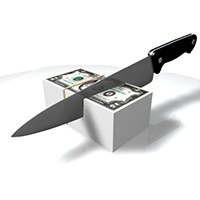The 4 aspects of food cost
Food cost has a direct impact on a restaurants’ operating profit. Because no two operations are identical, it is necessary to calculate the food cost of your particular restaurant monthly. Industry averages cannot be used as an accurate standard.
The concept of food cost must be examined at several different levels in order to take into account any and all variables. For example, one variable is your menu sales mix. When one menu item sells better than another, there will be variances in your overall
food cost and you should know how this affects your profits.
Essentially, there are four aspects of food cost that must be individually calculated for each operation:
* Maximum allowable food cost percentage
* Actual food cost percentage
calculated for the income statement
* Potential food cost percentage – determined by the menu sales mix
* Standard food cost percentage – includes a waste allowance
Maximum allowable food cost
The
maximum allowable food cost figure determines the food cost percentage an operation needs in order to achieve its profit objectives. It is calculated from the actual operating budget of the business.
To calculate the maximum allowable food cost
percentage, select a representative accounting period and determine the amounts for:
• payroll related expenses (salaries, wages, taxes, and fringe benefit)
• overhead expenses (advertising, utilities, maintenance, other supplies excluding
food costs).
• Also include a target figure for profits before tax.
Convert the dollar value for these three areas to a percentage of the total sales. Remember that food cost is not included. Now subtract these numbers from 100 to determine
the maximum allowable food cost percentage.
If you are working with following percentages of sales, payroll 27%, overhead 20%, profit 15%, then the maximum allowable food cost percentage is 37 % (100 minus 63 ).
Actual food
cost
The actual food cost percentage appears on the monthly income statement. This is the cost of the food consumed by your customers, and does not include employee meals or spoilage.
Although the actual food cost indicates what
the food cost is currently running, it has little value unless the operator knows what the target percentage should be.
Potential food cost
Potential food cost is a theoretical or ideal percentage which indicates what the
food cost should be in a perfectly run restaurant, given the sales mix. It reflects the fact that the most popular menu items will have the greatest influence on the overall food cost percentage.
To calculate the food cost percentage of each dish:
• Multiply the food cost per item with the number of portions sold
• Multiply the sales price by the number of portions sold
• Add both columns and then multiply the total cost by 100 and divide it by the total of the sales
column.
This will result in the potential food cost. If then your total cost is $ 3,000.- and your sales $ 10,000.- your potential food cost percentage will be 30.0.
If the sales mix produces a potential food cost that exceeds the maximum
allowable cost, profit objectives cannot be realized.
Standard food cost
Management needs to adjust the potential food cost to include waste and spoilage that occurs during normal preparation, as well as an allowance for
complimentary or discounted meals to employees and guests. An acceptable variance will range from half to three percentage points of food sales.
The exact percentage is determined from management studies. The standard food cost percentage is calculated
by adding this variance percentage to the potential food cost.
The difference between actual food cost and standard food cost reflects inefficiencies that should have been controlled by management.
How they relate
Bringing all four aspects of food cost together shows the importance of each in examining food costs
Assume that you have a maximum allowable food cost percentage of 35. The month-end food sales and inventory figures for the same period result
in an actual food cost percentage of 34.0. If the food cost analysis stops at this point, one may conclude that the cost of food is in line because the actual food cost is slightly below the maximum allowable food cost percentage.
However, further
analysis using the weighted sales mix analysis reveals a potential food cost percentage of 29.4. The variance that exists between the actual and potential food cost percentage is 4.6 percentage points, much too high for the existing menu sales mix.
Management has set a standards food cost percentage of 2 % to take into account as acceptable food waste, etc. The actual food cost percentage is still 2.6 percentage points higher than the standard food cost percentage. Thus minimum profit objectives are
being exceeded, but they are not being optimized. Investigation is required and its results could improve the financial performance of the restaurant in the future.
